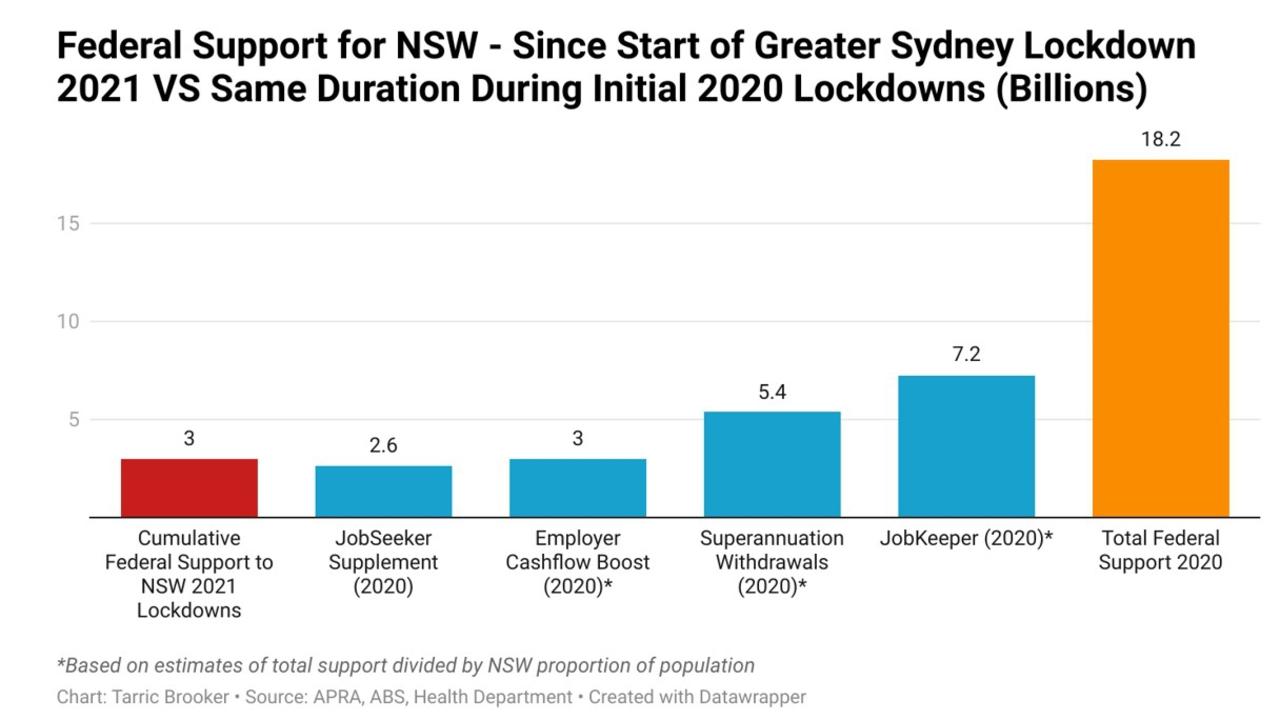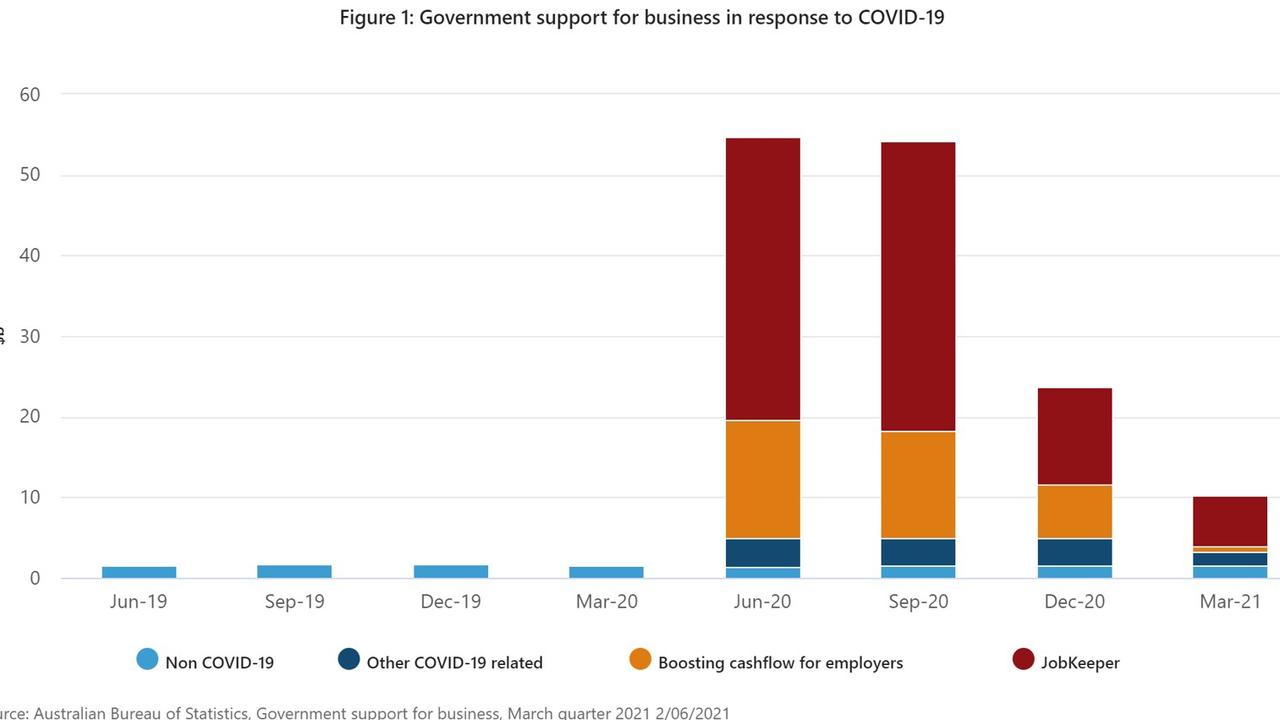Australia’s economic recovery in 2021 will be much tougher than 2020
Hitting 70-80 per cent of adults vaccinated signals freedom, but this milestone also comes with an alarming economic reality.
When lockdowns first came to Australia’s shores in March last year, the situation for households and businesses swiftly deteriorated.
In just a few days uncertainty became the defining characteristic of the nation’s economy, as unemployment queues stretched around the block of Centrelink offices around the country.
As concern and anxiety about Australia’s economic future continued to build in the community, the Morrison government committed to the largest economic support package in Australian history.
In total, the federal government’s stimulus programs are expected to total more than half a trillion dollars, almost 10 times the size of the Rudd and Gillard government’s support programs following the global financial crisis.

Between a run of lucky breaks and the advantages conferred on Australia by its geography, the nation coped remarkably well with the virus during most of 2020, with the unfortunate exception of Victoria.
As a result, the federal government’s stimulus measures actually ended up injecting far more money into the economy than was strictly needed.
The waste of JobKeeper
According to figures from the Parliamentary Budget Office, roughly 40 per cent of JobKeeper payments in the first three months of program were paid to businesses whose turnover did not fall by the required amount.
In dollar terms, between April and June last year approximately $12.5 billion was paid to businesses that did not experience a large enough drop in turnover to qualify for JobKeeper, at least on paper.
As for the remaining nine months of the JobKeeper program, the figures are yet to be released. But it wouldn’t be at all surprising to see a similar, or even greater levels of waste in the period between July and September last year.
Now as Australia confronts what is effectively ‘Pandemic 2.0’ in the form of the Delta strain, households and businesses living through the renewed lockdowns in NSW, Victoria and ACT, are being forced to cope with significantly less support.
Since the Greater Sydney lockdown began on the June 26 total federal support for NSW has amounted to $3 billion (as of August 24).
This includes the Morrison government’s Covid disaster payments, pandemic leave disaster payments and $200 income support payments.
Over a similar period of the same duration following the beginning of the initial lockdowns, total federal support programs for the NSW economy was around $18.2 billion.

This total includes JobKeeper, JobSeeker supplement, the business cash flow boost and superannuation withdrawals.
While the figure for the current round of federal support payments will rise significantly as a backlog of 1.19 million claims is slowly resolved, the level of support being provided may remain only a fraction of what was employed in 2020.
What happens when lockdowns ends?
Another major difference is the level of support that will be provided once lockdowns finally end and the economy reopens.
During 2020, when the economy reopened after the initial lockdowns, there was still up to nine months’ worth of JobKeeper and other federal support measures still to come.
In several states, such as Queensland and Western Australia in particular, this support was often not needed outside of industries hit by closed international borders.
Yet despite the immense cost to the nation’s coffers it continued to be paid all the same.

This effectively excess stimulus added enormously to the bottom lines of businesses who were recipients of the various government assistance packages.
With the federal government effectively subsidising a significant proportion of some businesses’ wage bills, this extra cash flowed into the economy and into assets such as cars and housing.
Many a home renovation, new jet ski or classic car was partially paid for through largely unneeded federal government support measures.
These additional tens of billions of dollars helped provide the fuel for the strong recovery the economy experienced in late 2020 and early 2021.
Whether or not this was money well spent or wasted, you can be the judge of that.
But as things stand today, this time will be different.
Rather than having tens of billions in government support yet to come even after lockdowns and restrictions end, this time it appears that the government is choosing the cold turkey option.
The big cut off
In a recent announcement Prime Minister Scott Morrison stated that once vaccination targets of 70-80 per cent of eligible adults had been hit, the federal support taps would be turned off.
Without the tens of billions of dollars in additional stimulus and superannuation withdrawals flowing into the economy even after the end of lockdowns, this recovery is likely to prove significantly more challenging.
During 2020 and early 2021 economists and commentators were blindsided by the swiftness of Australia’s strong economic recovery. With the luxury of hindsight, it’s clear why.
The generally very good management of the virus and a cash splash to households and businesses more than 15 times larger than Kevin Rudd’s GFC cash handouts, provided ample fuel for the economy to roar back to life.
But this time there will be a whole lot less cash flowing through economy and rising levels of concern about the health of the global recovery.
Perhaps this time the pundits will be as wrong about the outlook for 2021-2022 as they were for 2020, but only time will tell.
Tarric Brooker is a freelance journalist and social commentator | @AvidCommentator






